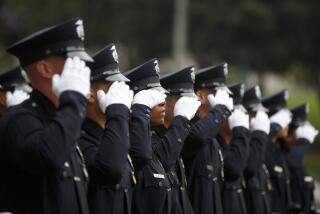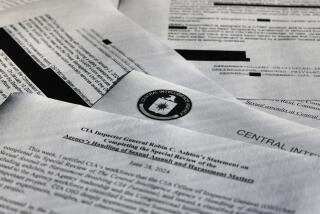CIA Manual Spells Out Interrogation Techniques
- Share via
The following are excerpts from a recently declassified CIA training manual describing methods once taught at the U.S. Army School of Americas for use against suspected subversives in Central America. The school trained Central American military officers in various techniques for handling and interrogating prisoners.
In 1985, facing congressional and public scrutiny over training techniques, the CIA revised the manuals to discourage the use of physical torture, instead emphasizing the use of “psychological techniques.” These excerpts are from the original, unedited manuals.
*
APPREHENSION: “The manner and timing of an arrest can contribute substantially to the ‘questioner’s’ purpose and should be planned to achieve surprise and the maximum amount of mental discomfort. [A suspect] should therefore be arrested at a moment when he least expects it and when his mental and physical resistance is at its lowest. The ideal time to make an arrest is in the early hours of the morning. When arrested at this time, most subjects experience intense feelings of shock, insecurity and psychological stress . . . “
*
HANDLING: “Subject is brought into the facility and handcuffed and should remain so during the entire processing. Any time the subject is moved for any reason, he should be blindfolded and handcuffed. Subject should be required to comply immediately and precisely with all instructions. Subject is completely stripped and told to take a shower. Blindfold remains in place while showering and a guard watches throughout. Subject is given a thorough medical examination, including all body cavities, by the facility doctor or nurse. Total isolation should be maintained after the first ‘questioning’ session. . . . Subject should be made to believe that he has been forsaken by his comrades. Throughout his detention, subject must be convinced that his ‘questioner’ controls his ultimate destiny and that his absolute cooperation is necessary for survival.
If a witness refuses to denounce the subject, the ‘questioner’ elicits and records remarks from him denouncing someone else known to him, for example, a criminal who was recently convicted in court. During the next session with the subject, these remarks, edited as necessary, are played back so that the subject is persuaded that he is the subject of the remarks.”
CELLS: “Cells should be about nine feet long and six feet wide. . . . Cell doors should be of heavy steel. . . . The slamming of a heavy steel door impresses upon the subject that he is cut off from the rest of the world. Window should be set high in the wall, with the capability of blocking out light. This allows the ‘questioner’ to be able to disrupt the subject’s sense of time, day and night. Heat, air and light should be externally controlled. Bedding should be minimal--cot and blanket--no mattress. The idea is to prevent the subject from relaxing. If there are no built-in toilet facilities, the subject should have to ask to relieve himself, then he should either be given a bucket or escorted by a guard to the latrine.”
THREATS: “The threat of coercion usually weakens or destroys resistance more effectively than coercion itself. . . . The effectiveness of a threat depends on the personality of a subject, whether he believes the ‘questioner’ can and will carry out the threat, and on what he believes to be the reason for the threat. A threat should be delivered coldly, not shouted in anger, or made in response to the subject’s own expressions of hostility.
When a threat is used, it should always be implied that the subject himself is to blame by using such words as, ‘You leave me no other choice but to. . . . ‘
If a subject refuses to comply once a threat has been made, it must be carried out. If it is not carried out, then subsequent threats will also prove ineffective.”
COERCION: “While we do not stress the use of coercive techniques, we do want to make you aware of them and the proper way to use them. . . . These techniques should be reserved for those subjects that have been trained or have developed the ability to resist noncoercive techniques.”
Compiled by Times staff writer Greg Norman
More to Read
Sign up for Essential California
The most important California stories and recommendations in your inbox every morning.
You may occasionally receive promotional content from the Los Angeles Times.










